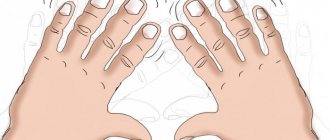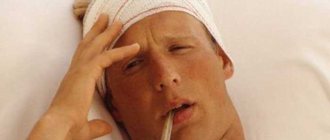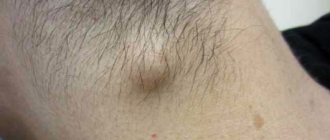Numbness in the back of the head is a condition that does not always indicate the presence of pathology. It may appear as a result of the fact that a person has been in an uncomfortable position for a long time or his head has been in one position for a long time. Most often this occurs during sleep.
The cause may also be a violation of blood circulation in one or another area of the head. This condition easily goes away after a little massage. But most often the cause of numbness in the back of the head is one or another disease. Moreover, this symptom should be considered one of the very first for the manifestation of certain neurological problems.
Why does it appear
It is very important to consult a doctor promptly if there are other symptoms - hearing loss, vision loss, fever. You should also be careful if you have problems with the musculoskeletal system, unsteady gait, a constant feeling of weakness, weakness, dizziness, or urinary incontinence.
And, finally, this is often the first sign of the onset of cervical osteochondrosis. Each reason should be examined separately, since each of them deserves special attention.
Causes of numbness in the back of the head
Numbness of the back of the head and neck is a relatively common complaint of many patients with long-term disorders of the cervical spine. But this sign may indicate more serious illnesses. There are many disorders that cause numbness in the back of the head, so proper examination is required to identify the cause.
Disorders of the cervical spine
Locking of the cervical spine due to contractions of the spinal muscles is among the most common disorders that cause numbness on the left side of the head or the right side.
Typical for this condition is aching pain in the neck when moving the head back and forth and sideways. The pain may radiate to one side of the head or to the forehead.
There is no fever or other symptoms other than headache.
Muscle stiffness and overload are also caused by excessive physical exertion (usually in an untrained person), sleeping in the wrong position, and careless head movements (sudden tilting, rapid rotations).
Osteochondrosis is another part of the body that causes numbness in the head; reasons include degenerative factors, excess weight, genetic predisposition, etc.
This disorder is characterized by a number of unpleasant manifestations: the patient may have pain and numbness in the back of the head, a burning sensation and pins and needles in the back of the head.
Similar manifestations are also typical for rheumatoid arthritis, which affects the cervical spine.
Treatment
Treatment options for vertebrogenic disorders:
- Reflective therapy. Various physical measures are used: heat (not recommended for acute lumbago), skin irritations (ice, cinnamon, pepper gel), massages (acupressure).
- Manipulation of soft tissues. Pressure on myogelosis, treatment of deep fascia.
- Specific methods. Stretching, post-isometric relaxation, anti-gravity methods, positioning, and physical therapy are used.
For rheumatoid arthritis, a number of classes of immunosuppressive drugs are used to suppress the inflammatory process. The classic therapeutic approach is the use of corticosteroids, but these drugs have a number of side effects. A relatively new method is biological therapy, in which drugs that suppress the immune system are given only when needed.
Migraine
If the back of the head goes numb, the reasons may lie in functional disorders of the head joints, typical of classic migraine. These blockages often worsen or even cause attacks. Relief in pain, attack frequency and duration is achieved by addressing the underlying cause.
Migraine affects about 18% of women (including young girls) and 5% of men in Europe. The incidence is shifting to younger and younger age groups.
Sometimes the approach of an attack is signaled in advance by the prodrome phase, which includes a feeling of fatigue, nausea, pressure in the head (in any part - back or front, left or right, on the top of the head). Approximately 20% of patients experience an aura, a visual perception in a certain part of the visual field. They bend, shine, shimmer.
Physical activity worsens the condition; a person seeks silence, peace, darkness and coolness. For some women, migraines are associated with the menstrual cycle. Attacks usually occur at the onset of bleeding, but also appear later or around ovulation.
High pressure
High blood pressure (hypertension) is an insidious disease that may not manifest itself for a long time. In some people, increased pressure is manifested by fatigue, headache (mainly in the frontal or posterior part, in the temples), dizziness, and numbness in the back of the head. Sometimes there is swelling of the face, a feeling of cottony legs that are insensitive to the touch.
Most people have no symptoms. But long-term hypertension causes complications. In particular, it worsens the course of atherosclerosis and related diseases, and over time can cause the development of other diseases, such as:
- coronary heart disease and lower extremities;
- myocardial infarction;
- ischemic stroke;
- narrowing of the renal artery;
- vascular dementia, etc.
When values increase above 230/130, we are talking about a hypertensive crisis, characterized by a high risk of developing various complications.
VSD
Vegetovascular dystonia (VSD) is a clinical diagnosis that combines a number of disorders associated with the functioning of internal organs.
Symptoms of the disease are varied. They appear both separately and in combination with signs of other somatic disorders. A specialized examination is required for correct diagnosis.
A sick person may feel dizzy and have blocked ears. He is often worried about hypotension or hypertension, circulatory disorders (due to narrowing of veins, arteries), numbness of the head, incl. back of the head, indigestion and other problems.
Meningeal syndrome
The left side of the head, its right side or the back of the head also goes numb with meningeal syndrome. Other signs include:
- headache (in particular in the cheekbones);
- nausea;
- vomiting;
- photophobia.
Consciousness, as a rule, is not impaired, only occasionally states of confusion or short-term unconsciousness occur. There is severe rigidity of the upper spine and neck - the patient cannot tilt his head. Paradoxically, the ability to move the head to the sides remains.
In addition to meningitis, meningeal syndrome can occur with subarachnoid hemorrhage and tumor metastases to the brain.
Fever
Increased body temperature (above 38°C) can cause headaches and other symptoms (in particular, with a fever, the scalp becomes numb and stiffness in the back of the head appears). For this reason, it can sometimes be difficult to distinguish a relatively common infection from meningitis.
Causes:
- infectious diseases;
- autoimmune disorders;
- tumor processes;
- increased thyroid function;
- complications of transplantation and transfusion;
- tissue damage;
- intoxication with drugs and other substances;
- heatstroke;
- malignant hyperthermia.
Traumatic brain injury
Numbness in the back of the head after injury is a fairly common occurrence. Moreover, this symptom can appear both immediately after the injury and some time after it. Therefore, you should definitely consult a doctor, since the outcome of this condition is difficult to predict.
In addition to the feeling of numbness, there may be other symptoms that patients complain about. This:
- Headache.
- Pain in the neck.
- General weakness.
- Memory impairment.
Treatment will depend on many factors. In some cases, drug therapy is sufficient, and sometimes it is necessary to resort to surgery.
Diagnosis and treatment methods
Numbness in the neck requires contacting a neurologist.
If the development of vascular pathology is suspected, rheoencephalography or electroencephalography is prescribed.
Organic brain damage and multiple sclerosis are detected using ultrasound and magnetic resonance imaging. In cases where numbness is accompanied by increased thirst, it is necessary to consult a physician and obtain a referral for a laboratory blood test to determine the level of glucose and glycated hemoglobin in order to rule out diabetes mellitus. Therapeutic techniques depend on what caused the pathological condition:
- Dry heat, rubbing, light massage and rubbing in a warming ointment help restore blood circulation in case of hypothermia or prolonged stay in one position.
- Surgical treatment is prescribed for hernia and tumor processes.
- Rest, taking painkillers and medications that improve the trophism of nervous tissue are recommended for spinal injuries.
- Pathologies of the cardiovascular system involve taking medications that normalize blood pressure, prevent the formation of blood clots, and restore blood circulation in the problem area.
Therapy for osteochondrosis or cervical hernia requires taking anti-inflammatory drugs, painkillers and antispasmodics. Diagnosed diabetes mellitus requires taking medications prescribed by your doctor.
Pinched nerves
Pinched nerves in the head area occur relatively often. This is called neuralgia, and hypoesthesia is one of the symptoms of this disease. Neuralgia can develop when a variety of nerves are pinched, but the trigeminal, facial and maxillary nerves - upper and lower - are mainly affected.
Infringement of nerve tissue occurs for various reasons. This may be a tumor, dilated blood vessels, adhesions, as well as some other factors, for example, bone fragments after a fracture.
In addition to complete loss of sensitivity, there will be other manifestations, including sharp pain that spreads to the right or left side of the face. It occurs not only on its own, but also at the moment of touching the face.
Which doctor should I contact?
The causes of numbness in any area of the head (face, back of the head, right or left side) will be different factors and situations. There is no need to make a diagnosis yourself. To identify the exact causes, you need to contact medical specialists.
The very first doctor to confirm or rule out pathology of the nervous system should be a neurologist. The feeling of numbness is associated with loss of sensitivity, which means that somewhere the passage of electrical impulses along the nerve fiber is disrupted.
A common cause is osteochondrosis of the cervical spine; due to chronic changes in the intervertebral discs, the nerve roots are pinched by neighboring vertebrae. A more serious cause may be a stroke.
Symptoms are sometimes associated with compression of nerves and blood vessels. There is a decrease, sometimes significantly, in the access of nutrients and oxygen to tissues.
The lack of these important elements in a certain area of the muscles and skin creates conditions under which the sensitivity of nerve receptors is disrupted, and a feeling of numbness occurs. It may appear against the background of vascular sclerosis, arterial plaques, or blockage by a detached blood clot.
The obligatory specialist to visit will be a doctor who deals with vascular pathology - a vascular surgeon.
If a person has been suffering from diabetes for a long time, and part of his head has become numb, the issue should be resolved together with his treating endocrinologist. Regularly elevated blood sugar levels lead to nerve damage, and this can provoke the development of paresthesia.
If trauma is the reason that your head is numb, the first doctor you need to see should be an orthopedic traumatologist. It determines what is damaged in the musculoskeletal system, the extent of the damage, and whether rehabilitation is needed. If necessary, the traumatologist can prescribe a consultation or treatment with a surgeon.
Incorrect bite can be one of the reasons for facial numbness. Deviations from the norm in the bite cause additional stress on the jaw muscles and chewing joints. The facial nerve is compressed and paresthesia develops.
To correct the bite and get rid of these unpleasant sensations, treatment by an orthodontist is required.
In rare cases, facial paresthesia occurs after tooth extraction when the nerve has been damaged. If this happens, you need to return to the dental surgeon who removed the tooth so that he can prescribe treatment.
If other specialists have not confirmed the presence of pathology in their area, then perhaps the appearance of a feeling of numbness is associated with an infection that has entered the body and affects the nervous tissue. Here you will need to consult an infectious disease specialist.
With a viral or bacterial infection of the middle ear, sinuses, throat, or respiratory tract, inflammation of the trigeminal nerve may occur. Or with meningitis.
There is another disease - Lyme disease (borreliosis), which occurs when a tick bites. The cause will also be any infection, the complications of which may lead to numbness in the head.
Sometimes paresthesia occurs with autoimmune diseases (systemic lupus erythematosus, multiple sclerosis). The immune system, for unknown reasons, begins to attack tissues, mistaking them for foreign. Here a visit to an immunologist will be necessary.
If a person has been exposed to chemicals that have led to intoxication of the body, and he has a feeling of numbness, emergency medical care is needed to cleanse the blood of toxins and the help of a toxicologist.
Sometimes the head can go numb as a result of psychological pressures that are associated with stress. A person does not even notice how he takes a certain position, in which the muscles are overstrained, and they compress the nerves.
Here you will need a consultation with a psychiatrist who will prescribe sedatives, or the help of a good psychologist.
Once again, we list the doctors whose help may be needed to determine the causes of numbness of the scalp:
- Neurologist;
- Vascular surgeon;
- Endocrinologist;
- Traumatologist;
- Dentist;
- Infectious disease physician;
- Immunologist;
- Toxicologist;
- Psychiatrist or psychologist.
It happens that paresthesia occurs due to compression of the spinal cord or brain by various tumor processes. This is done by an oncologist.
Multiple sclerosis
The cause of numbness in the back of the head may be multiple sclerosis. This is a chronic, incurable, progressive disease that does not yet have a treatment that would help the patient recover.
In this case, the membrane that covers the nerves begins to degenerate into connective tissue. Because of this, the functioning of the nervous system is disrupted, which negatively affects human health.
There are a great many symptoms of this disease, so it is possible to make an accurate diagnosis only after some time.
For example, a patient may complain of trembling of the arms and legs that continues for a long time, unsteadiness of gait, memory problems and dizziness. To make an accurate diagnosis, you should undergo a test such as an MRI. It will show the state of the nervous system and how much the nervous tissue has been destroyed.
Possible diseases
In medical practice, there are a number of diseases for which the symptom of numbness in the back of the head is specific.
Precursors of stroke in women and men
| Disease | What kind of pathology | Symptoms |
| Osteochondrosis | Pathological changes in the cervical spine, which are characterized by damage to the functions of the intervertebral discs and the transformation of cartilage tissue into bone. Due to pathological changes, pinching of blood vessels and nerves occurs, as a result, blood circulation in the brain is disrupted and innervation to the central nervous system is disrupted. |
|
| Vegetovascular dystonia | The parasympathetic type of work of the central nervous system, in which the blood vessels of the brain periodically narrow or rapidly expand. The disease is characterized by a chronic course, requiring, as a rule, only symptomatic treatment. |
|
| Hypertension | Appears against the background of impaired blood circulation in the vessels of the brain, or against the background of a disturbed psycho-emotional state, as well as with cardiac pathologies. The disease is characterized by a long course and frequent attacks, which often leads to strokes. | High blood pressure is accompanied by a hypertensive crisis (active release of blood from the ventricles of the heart into the blood vessels). Blood rushes to the brain, causing numbness in the occipital region and other parts of the body. The person also feels a sharp headache and throbbing in the temples. |
| Stroke | In this pathological condition, vascular obstruction is noted, which leads to acute disruption of blood circulation in the brain. The pressure in the vessels reaches a maximum and this leads to rupture of the walls of blood vessels and hemorrhages in the brain. | If the attack is not stopped and appropriate measures are not taken, after 2 hours necrosis of the affected parts of the brain is diagnosed. As a result, paralysis of individual limbs or completely one half of the body may occur, voice or hearing may be lost, speech and coordination of movements may be impaired. Stroke often causes death. Associated symptoms:
|
| Atherosclerosis | Formation and deposition of cholesterol plaques in the blood vessels of the brain. By adhering to the walls of blood vessels, they become an obstacle to blood flow, and as a result, blood circulation in the brain is disrupted. If plaques come off, they completely block the patency of the vessels - this leads to an absolute cessation of blood flow to the brain. |
|
| Avitaminosis | Deficiency of B vitamins, as well as microelements such as calcium, magnesium, potassium leads to damage to nerve processes and fibers. |
A light head massage and gymnastic exercises help relieve the condition. |
| Pinched nerves (neuralgia) | The entrapment may involve the trigeminal, facial, maxillary or mandibular nerve. A similar condition occurs against the background of tumor growth, thickening of the walls of blood vessels, and adhesions. |
|
| Multiple sclerosis | An autoimmune chronic disease characterized by the destruction of the membrane of nerve endings, in place of which connective tissue is formed. Replacement with connective tissue can be observed throughout the entire area of the nervous system, forming multiple foci. |
|
| Tumors in the brain | An increase in the size of the tumor leads to pinching of blood vessels, reducing the space of the cranium. The resulting pressure affects the brain tissue and membranes. As a result, brain functioning is impaired. |
|
| Diseases of the musculoskeletal system (in particular the cervical vertebrae) | An unpleasant symptom of numbness occurs after the body and head are in one position for a long time. Pathological changes in the musculoskeletal system lead to disruption of blood circulation in the vessels and hypoesthesia. |
|
| Traumatic brain injury | As a result of injury to the craniocerebral apparatus, problems may arise in various organs and structures of the body. Sometimes symptoms appear immediately, sometimes after 2-3 days. Often such injuries lead to swelling of the brain, the formation of hematomas, and hemorrhages. |
|
Tumors
The causes of numbness in the back of the head are tumors, both malignant and benign. The tumor, which is constantly growing in size, puts great pressure on the brain, since it cannot go beyond the skull.
Depending on where this compression occurs, a variety of symptoms will appear. This condition can be suspected if you complain of a severe and constant headache. However, only an MRI scan of the brain will help make an accurate diagnosis.
What examinations are required
Before making a diagnosis, any doctor prescribes a series of tests and undergoes the necessary examinations.
Of them:
- Blood test (general, biochemical, hormones, infections, toxic substances). The blood is tested to find out whether there is a harmful agent in the blood or not, whether all substances and cells are in sufficient quantity, or whether something is missing. Along with a blood test, your doctor may prescribe a urine test to get a more complete picture of how your body is functioning.
- Doppler ultrasound (ultrasound examination of neck vessels). If the scalp becomes numb, the doctor may suspect problems with the patency of the blood vessels in the neck. Ultrasound examination helps to visually trace the passage of blood flow (speed, direction) and record obstacles in the vessels (atherosclerotic plaques, blood clots, abnormal bends).
- CT scan of the head. Computed tomography collects information about the state of the brain by taking layer-by-layer images. This way you can see injuries, foreign bodies, inflammation of the membranes of the brain, hemorrhages and tumors.
- MRI of the brain. Magnetic resonance imaging creates a three-dimensional image of organs. All details of organs and tissues are visible in 3 dimensions.
- X-ray of the skull. If there is a symptom of numbness, the doctor may prescribe an x-ray as a diagnosis to identify or exclude pathology from the bones, sinuses, and base of the skull. In X-ray images you can see the soft tissues of the brain and obvious changes in them.
Stress
Any stressful conditions negatively affect the patient’s health. The central nervous system, in particular the brain, is especially affected in this case. This happens due to vasospasm, and the brain does not receive enough blood.
This can cause a wide variety of symptoms, many of which need to be treated by a neurologist. With constant stress, disorders in the brain can lead to the development of a variety of diseases, and numbness in the back of the head will become one of their symptoms.
What to do when the back of your head is numb
Numbness in the back of the head occurs more often than other symptoms in this part of the head.
The patient may feel a burning sensation, tingling, or goosebumps. The head may feel dizzy, the ears may become blocked, and the vision may become dark. As a result, coordination of movements worsens; this condition can even provoke fainting. If the causes of pain can be studied, then numbness is a more complex problem.
Causes
In modern medicine there are physiological and pathological provoking factors. The first are related to:
- Staying in one position for a long time. This worsens blood circulation, pinches nerves, and causes spasm.
- Incorrect body position in sleep. If the pillow is too high or completely absent, the blood supply to the brain is worsened. As a result, dizziness begins and the back of the head goes numb.
- The position of the body in space changes sharply. For this reason, vascular spasms occur.
- Hypothermia.
- Stressful situations.
When signs of numbness and tingling do not disappear within 15 minutes and recur from time to time, you need to contact a specialist to determine the cause.
Pathological factors affecting the development of this condition include:
In 80% of examples, numbness is caused by the following diseases:
- Osteochondrosis.
- Hypertension.
- High ICP,
- Neuralgia.
Osteochondrosis
This is a pathology of the cervical spine, in which there is a loss of functionality of the intervertebral discs and the transformation of cartilage into bone. Nerve fibers and blood vessels become pinched, causing problems with blood circulation and innervation of the nervous system.
Signs:
- My head is spinning.
- The back of my head goes numb.
- Pressure changes.
- Visual function deteriorates and a person may go blind.
- My head hurts.
Osteochondrosis responds well to therapy, which uses medications to stabilize the blood circulation process. Non-steroidal anti-inflammatory drugs, often doctors prescribe massage treatments.
Sometimes it is necessary to use a bandage to support the head and relieve tension from the muscle tissue. You need to use a woolen scarf to cover your neck.
You must first treat the skin with ointment. This eliminates swelling and pressure from nerve fibers and arteries, improves blood circulation.
How to help yourself
The reasons why the back of the head goes numb can be different. These are diseases or destruction of nerve fibers. In addition to examinations by a doctor, you need to pay attention to prevention. You need to do exercises. Choose several exercises, after which the muscle tissues pleasantly relax and the body is saturated with energy. Sudden body movements should be avoided.
It is preferable to check your own sleeping place. Is the bed too soft and is the pillow chosen correctly? Before going to bed, you should try to ventilate the bedroom so that there is enough oxygen. Unlike other formed elements in the body, neurons die very quickly due to lack of oxygen.
The diet requires adjustment. It is necessary to provide the body with a vitamin complex and amino acids. It is advisable to learn to control your emotions so that stress does not arise.
When to contact specialists
Primary signs may lead the patient to the need for examination and referral to specialists. It is not recommended to delay diagnosis and therapy, since the brain is located near the back of the head and neck.
Numbness may be accompanied by the following symptoms:
- Fatigue, headache.
- Drowsiness, weakness in muscle tissue throughout the day.
- Problems with coordination of movements.
- The head becomes dizzy and the person begins to feel nauseous.
- Problems with pronunciation.
- Difficulty controlling bowel movements and urination.
You should immediately consult a doctor for help in the following cases:
- Hearing, speech function, and vision deteriorate at the same time.
- Head pain and a feeling of numbness are not eliminated after using painkillers and anti-inflammatory drugs, ointments and massage procedures.
- The temperature rises sharply, heat is felt in the head, and redness is observed.
- Only the left or right side is numb, there are problems with facial expressions, and paralysis occurs.
Diagnostics and therapy
If there is constant numbness of the skin on the head and neck, you should consult a doctor if the duration of the seizures is more than 2-3 minutes.
Diagnostics should involve the following methods:
- A blood test can determine anemia as a result of iron deficiency, Addison-Brimer pathology, which aggravates the blood supply due to a small amount of vitamin B12.
- X-rays and MRIs can reveal skeletal deformities and other diseases in which the nerve fiber is pinched and the back of the head goes numb.
- Electroneuromyography determines the location of damaged nerves, identifies neuropathy and carpal syndrome.
- Ultrasound and Doppler sonography determines the pathology of the vascular system and problems with blood circulation in some of the main arteries.
Depending on the symptoms of numbness, other examinations may be necessary. A history of skull injuries requires consultation with a surgeon and a traumatologist. As people experience numbness in the chin area during orthodontic procedures, they come to the dentist. In case of damage to internal organs, it is necessary to conduct an examination based on several basic parameters.
Depending on the reasons, the following may apply:
- Corsets.
- Anti-inflammatory drugs.
- Analgesics.
- Compresses to warm up the problem area.
- Massage treatments.
The choice of a suitable therapeutic technique is determined by the causes of numbness and is carried out after complex diagnostic procedures. Full rehabilitation sometimes takes a long time, but it will be possible to complete therapy to eliminate various complications that pose a danger to existence.
During hypoesthesia, caution is required near heat sources when eating food, since sensitivity problems sometimes cause accidental injury to the oral cavity or a burn. It is undesirable to find yourself in situations where such numbness occurs because the influence of external factors can determine the intensity of such symptoms.
Since hypoxia can contribute to numbness, you need to ventilate the room all the time. Sometimes you have to undergo psychotherapy to get rid of mental problems caused by disorders due to the symptoms that appear.
Some diseases require surgery and long-term rehabilitation. The specialist determines how specifically to treat the disorder.
Often, numbness in the back of the head is a common symptom that indicates another clinical diagnosis; sometimes a dangerous pathology can occur. Neurologists are involved in diagnosis and determination of appropriate therapeutic modalities. The doctor will need the patient's trust and willingness to treat. It is unacceptable to carry out therapy on your own; specialists must diagnose and treat people.
Source: https://nevrology.net/sindromy-i-zabolevaniya/simptomy/nemeet-zatylok.html









